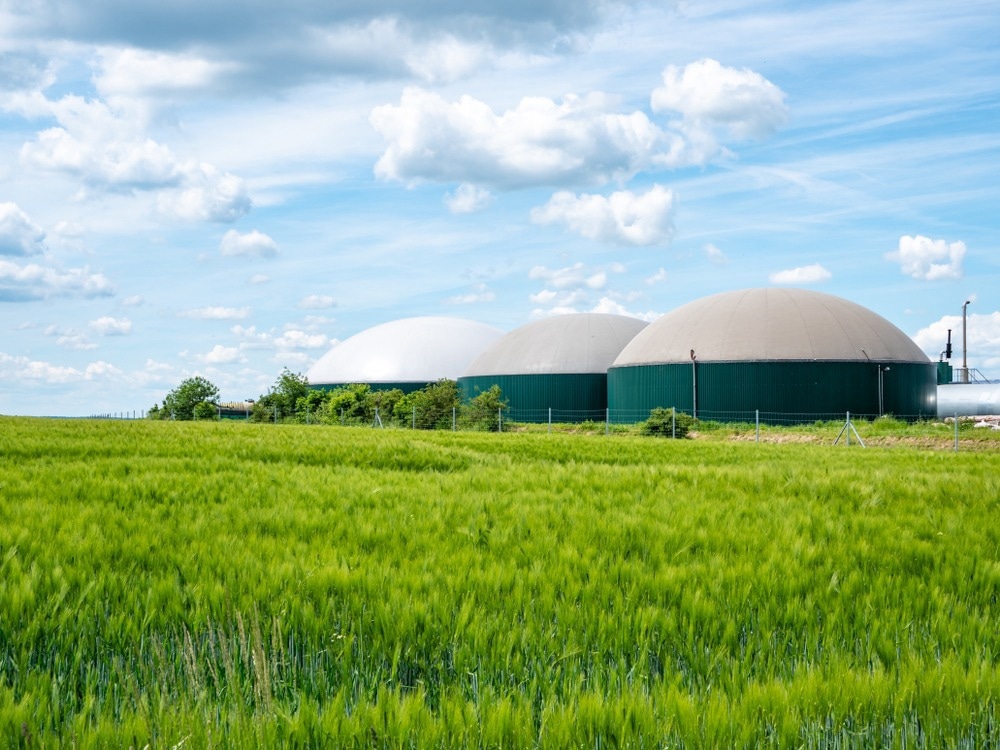
Image Credit: Animaflora PicsStock/Shutterstock.com
Renewable natural gas needs to be upgraded so that its quality is closer to the fossil-based natural gas we typically extract and use. This gives it a methane concentration of at least 90%, which makes it possible to distribute the gas to the market through existing infrastructure and use it in ordinary appliances.
To maximize efficiency in biomass to renewable natural gas conversion processes, large-scale production facilities are used and located close to transport links such as ports or rivers. Many plants are also located close to existing, possibly out of use, gas storage facilities so that production can continue even during periods of low market fluctuation and weak demand.
There are numerous ways of methanising (increasing the methane content in) carbon dioxide and carbon monoxide, two gases commonly used to make renewable natural gas. The three main processes are:
• Anaerobic digestion
• The Sabatier reaction
• Thermal gasification
Anaerobic digestion is done in dedicated anaerobic digesters or sometimes occurs as a byproduct that can be collected from landfills and wastewater treatment sites in gaseous form.
For renewable natural gas, bacteria cultures are applied to organic material, which releases methane as they process the material. It also occurs naturally in shallow lagoons.
Biogas is typically made in anaerobic conditions from the microbial degradation of some kind of organic matter such as waste material. It is composed primarily of methane and carbon dioxide, although other trace gases tend to be present.
In the Sabatier reaction method, hydrogen and carbon dioxide react with one another at high temperatures of between 300 °C and 400 °C and pressure up to 3 MPa. In these conditions, the reaction produces methane, captured as renewable natural gas, and water.
Thermal gasification methods heat up an organic feedstock to a critical temperature at which methane is released but the material does not burn. Captured methane can be processed into renewable natural gas.
Is Renewable Natural Gas Environmentally Friendly?
Nearly any feedstock containing some kind of organic compound is potentially a suitable candidate for renewable natural gas processing. Sludge from settled wastewater and landfills containing organic waste is commonly used as renewable feedstocks. These have the economic and environmental advantage of making use of otherwise wasted material.
Energy crops are another good, sustainable source of feedstock for renewable natural gas production. Crops that grow quickly in harsh conditions are preferred, although concern needs to be given to the dangers of monocropping when assessing the environmental benefits of a particular renewable natural gas source.
Renewable natural gas made from energy crop feedstocks has a distinct environmental advantage. Growing plants have their own carbon capture and sequestration technology, using photosynthesis to pull carbon dioxide out of the atmosphere and replace it with oxygen.
As a result, renewable natural gas made from energy crop feedstocks is commonly considered a carbon-neutral energy source.
Renewable natural gas adds less carbon dioxide to the atmosphere when it is burned than fossil fuel-based natural gas. This is because it either releases carbon dioxide that would otherwise be released by waste feedstocks or because the amount of carbon it releases is restored by the next generation of energy crop plants.
Renewable natural gas makes use of organic waste that would otherwise take up space and energy to process.
Renewable natural gas presents largely the same environmental risks as common fossil fuel-based natural gas. It releases carbon monoxide, sulfur dioxide, nitrogen oxide, hydrogen sulfide, and particulate matter into the local atmosphere when burned, as well as methane which is a long-living greenhouse gas.
Can Renewable Natural Gas Be Viable?
One of the key benefits of renewable natural gas is that it can be produced, distributed, and consumed with existing grid infrastructure and appliances. This makes it a promising alternative heat and energy source that does not require initial capital investment from consumers.
Due to the relatively simple physics of gas transportation, existing infrastructure can move gas over long distances with minimal loss of energy. Remote locations rich in low-cost biomass, such as Scandinavia, can be readily linked with industrial and residential needs throughout Europe.
There is also an abundant source of feedstock material available. Sewage, food waste, and organic waste from numerous industrial processes such as brewing can all be gasified to retrieve residual energy and use it in place of fossil fuels.
In one study, it was found that biosolids in US wastewater alone could provide feedstock for enough biogas to meet 12% of America’s national demand for electricity.
In the UK, the National Grid has stated that a minimum of 15% of the country’s current gas consumption could be replaced with renewable natural gas from readily available sources.
Renewable Natural Gas Projects
The UK has approximately 90 sites for biomethane injection in anaerobic digestion-based renewable natural gas processing. Meanwhile, UK energy company Ecotricity has announced its intention to provide renewable natural gas to UK customers.
FortisBC, a gas provider in Canada, also utilizes renewable natural gas in its existing gas distribution system.